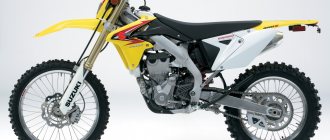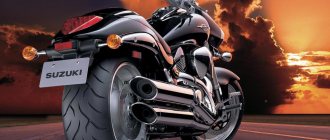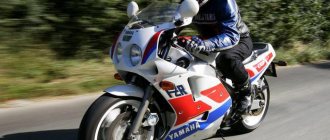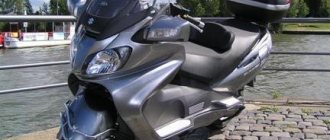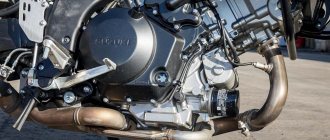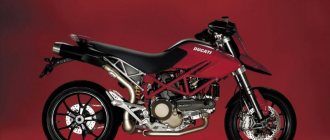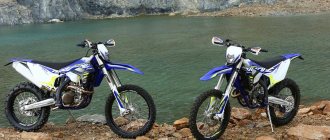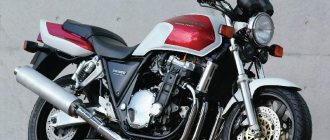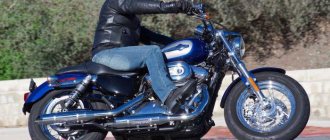A few years after the launch of the naked SV650 series, Suzuki engineers decided to create an older, flagship version with an engine capacity of 1,000 cubic meters . In 2003, the first sample of the Suzuki SV 1000 appeared, and production began in the same year. The motorcycle largely replicates the appearance of the younger version. There are also a few differences in the filling, taking into account the fact that it is a liter. It should become more powerful, faster, more dynamic, etc.
Bad results
There are many positive qualities in the SV 1000, but none of them allow us to clearly qualify the motorcycle.
But such copying led to an unexpected result.
The new version sold poorly. Even the fact that this bike was offered not only for export did not save the situation.
It was also possible to meet him in domestic markets. In 2007, the company came to the conclusion that the production of a liter was no longer profitable , warehouse stocks were sold out and the Suzuki SV 1000 became history.
During its short life, the motorcycle received several ergonomic and cosmetic changes. There were no major restylings. The only noteworthy detail is that the Suzuki DL1000 V-Strom .
Latest posts Popular The most interesting motorcycle news
you are reading the most popular news you are reading all the news you are reading the latest news read the most popular read all the news read the latest news
The excellent smooth running is due to the injector from the SDTV system with double throttle valves. Moreover, the maximum power that this vehicle is capable of producing is 125 horsepower, and its torque is 201 newton-meters. Despite the general and external similarity, the liter model has a number of differences from the Suzuki SV 650, as well as its Japanese version, the Suzuki SV 400. In fact, they only have a common layout, although it differs from the 650 cc four hundred only in the piston and some other little things. But the liter model is a completely different matter. It has enough power to outrun numerous sports bikes on the road. In order to accelerate from 0 to 100 kilometers per hour, this vehicle will need only 3.5 seconds, while its maximum speed reaches 250 kilometers per hour.
The wind protection, which is achieved thanks to the presence of a standard fairing, is quite good during everyday driving, but already at a speed of 140-150 kilometers per hour it begins to fail, and having accelerated to 200 kilometers per hour, the wind stream strives to rip the motorcyclist off the seat. In order to cope with such a problem, you can choose one of three solutions - do not ride at such high speed, replace the existing glass with a higher one, or lie on the gas tank like a sports bike to hide from the wind, fortunately the design of the motorcycle does not prohibit such a position .
Over the course of its five-year production, the Suzuki SV 1000 has undergone various changes. So, in 2004, it was decided to reduce its height along the saddle by 2 centimeters by installing a different type of subframe; in addition, the rear wing was slightly reduced. In 2006, it was decided to change the throttle body, thanks to which its power increased to the above-mentioned 125 horsepower. But the most important thing remained unchanged - excellent traction in any of the operating ranges and a rich sound emitted by the exhaust. Fuel consumption starts at approximately 6 liters per hundred kilometers.
With such impressive power for a classic motorcycle, this bike is also lightweight. Its dry weight is only 185 kilometers, which is comparable to most four hundred models. As a result, the power supply of the Suzuki SV 1000 motorcycle is at the highest level. It is also good that the designers from Japan did not ignore this and installed a brake that is unique in its grip on the motorcycle, installing two 310 mm brake discs on the front with 4-piston calipers.
In fact, such a vehicle can be safely called universal. Its excellent handling and unique power make it a blast on the track, while its smooth, smooth ride makes it great for cruising around town. The gasoline tank has a volume of 17 liters and, after installing the case, you can go on a long trip, taking everything you need with you. All this makes the SV 1000 an excellent alternative for all fans of classic modern motorcyclists who gravitate towards the character of V-twin engines rather than in-line engines.
Specifications
The motorcycle received its engine from a sportsman Suzuki TL1000. Its power was reduced, which allowed it to level out traction throughout the entire rev range.
| Suzuki SV1000 | parameter |
| Motorcycle class | naked |
| Year of production | 2003-2007 |
| Frame | aluminum cast |
| engine's type | 2-cylinder, 4-stroke, liquid cooled, fuel injection, SDTV, L-shaped pistons (V-shaped forward) |
| Working volume | 996 cm³ |
| Bore/Stroke | 98.0 x 66.0 mm |
| Ignition type | transistor |
| Maximum power | 94.0 hp (69.1 kW) at 8500 rpm – SV1000 / SV1000S (Japan) 120.0 hp (88.3 kW) at 8500 rpm – SV1000 / SV1000S (except Japan) 2003-2004 125.0 hp (92.0 kW) at 9000 rpm – SV1000 / SV1000S (except Japan) 2005-2007 |
| Maximum torque | 102.0 Nm (10.3 kg*m) at 7000 rpm |
| Transmission | 6-speed |
| type of drive | chain |
| Front tire size | 120/70ZR17M/C (58W) |
| Rear tire size | 180/55ZR17M/C (73W) |
| Front brakes | 2 discs, 310 mm, 4-piston calipers |
| Rear brakes | 1 disc, 220 mm, 1-piston caliper |
| Front suspension | Telescopic fork 46 mm (all adjustments), travel - 120 mm |
| Rear suspension | Pendulum with monoshock absorber (all adjustments), stroke - 130 mm |
| Minimum ground clearance (clearance) | 150 mm |
| Acceleration to 100 km/h | 3.08 sec |
| Acceleration to 100 km/h | 3.08 sec |
| Comfortable cruiser | 120 km/h to 160 km/h |
| Maximum speed | 235 km/h |
| Gas tank volume | 17.0 l |
| Power reserve | 200-250 km/h |
| Fuel consumption | 5.44 l. per 100 km |
| Motorcycle weight (dry) | 186 kg |
Features include fuel injection , SDTV , L-shaped pistons ( V-shape pushed forward ). And also slightly reduced characteristics for installation on bikes that are planned for sale in domestic markets. Otherwise it is a standard 2-cylinder , 4-stroke liquid-cooled engine .
Two-cylinder engine.
Cooling system radiator.
Classic chain drive.
Transmission and clutch
The engine was equipped with a 6-speed gearbox.
There are no complaints from users about it - the numbers are convenient, gears are engaged without questions, neutral is found immediately. Elasticity is noted: accelerating to 100 km/h in first is no problem, 25 km/h in sixth - please, on the highway at 200 km/h - no problem!
- The clutch is standard - in an oil bath , power transmission is hydraulic .
- The main drive is standard - chain .
Brakes
Front brakes.
Rear brakes.
There are complaints about the rear brake. According to reviews: “ It’s as if it’s not there, but nevertheless the pads need to be changed .” There are no other problems . Hydraulic discs. 2 discs on the front 1 disc on the rear . The diameter of the brake rotors is 310/220 mm . 4-piston brake caliper at the front, 1-piston at the rear.
No options are offered.
Suzuki SV 1000
Brief review of Suzuki SV 1000
The Suzuki SV 1000 road motorcycle is the flagship of the SV series, equipped with an L-shaped (V-shaped with a cylinder angle of 90 degrees) engine with excellent torque. There are also younger models - Suzuki SV 400 (for the Japanese domestic market) and Suzuki SV 650 (export version), and the latter SV 1000 has a lot in common - a gas tank, a plastic body kit and other elements. The motorcycle was produced in two versions - a regular one, without plastic and with a round headlight, and the SV 650S, equipped with a plastic fairing and having a more sporty, forward-leaning riding position due to the higher position of the driver's footrests and a slightly different arrangement of controls.
The main distinguishing feature of the SV 1000 is smooth and smooth traction throughout the entire rev range, without pronounced pick-ups and dips. This smooth power take-off curve from the engine is ensured by the V-twin engine. Thus, despite its more than impressive power, the SV 1000 is perfect for lovers of a relaxed driving style who want to be able to accelerate sharply when necessary, for example, to overtake. The motorcycle does not have any significant “inherent problems”.
During its release, the SV 1000 changed slightly. Since 2004, it has received a 2 cm lower seat height, and since 2006, dual throttle valves and an increased compression ratio, resulting in increased maximum power. The remaining changes were purely cosmetic.
Similar motorcycles:
- Honda CBF 1000
- Yamaha FZ-1
Technical characteristics of Suzuki SV 1000
- Years of production: 2003-2007
- Class: road
- Frame: light alloy
- Engine: 4-stroke, 2-cylinder, V-shaped
- Engine capacity, cubic meters see: 996
- Cooling: liquid
- Valves per cylinder: 4
- Fuel supply: injector
- Power: 125 hp (before 2006 - 123.5) at 8500 rpm
- Torque: 102 Nm at 7000 rpm
- Maximum speed, km/h: 205
- Acceleration from 0 to 100 km/h: ~3.5 seconds
- Transmission: 6-speed
- Wheel drive: chain
- Front tire: 120/70-17
- Rear tire: 180/55-17
- Front brakes: 2 discs 310 mm, 4-piston calipers
- Rear brakes: 1 disc 220 mm, 1-piston caliper
- Front suspension: telescopic cartridge fork with a full range of adjustments
- Rear suspension: monoshock absorber with a full range of adjustments
- Gas tank volume, liters: 17
- Fuel consumption at 110 km/h, liters: ~6
- Dry weight, kg: ~185
Pros and advantages of Suzuki SV 1000
- Smooth and powerful traction throughout the entire rev range
- Effective engine braking
- Low center of gravity
- Good brakes
- Good wind protection (SV 1000S)
Pros and cons of the Suzuki SV 1000
- High consumption, especially at high speed
- Small power reserve
- Noticeable vibrations at high speeds
- Mediocre visibility through standard mirrors
Driving performance
The maximum speed declared by the manufacturer is 235 km/h . The owners say that the acceleration is normal, but you can’t give it more than 170 km/h , the headwind simply interferes. Moreover, although the Japanese deny it, there is a limiter at 195 km/h . Comfortable cruiser over a wide range from 120 km/h to 160 km/h .
Only the S version, a sporty modification of the model, can be called a comfortable cruiser. In the regular naked version, any wind protection is completely absent.
Peculiarities
“Esveha” is best suited for the city and medium-range.
Although the motorcycle had much in common with the younger model, it nevertheless had its own unique features.
- Vibration . The steering wheel and tank shake constantly while driving. There is no treatment. After 100 km of running, my hands begin to ache.
- Landing . High footpegs seem to set you up for a sporty riding position. The original saddle does not hint at long trips.
- Pendant . All adjustments provide a wide range of variations, but the factory settings are quite suitable for driving on Russian roads.
- Motorcycle for one . Although the second number accelerates well, controllability and maneuverability decrease. The footpegs and handles for the second number are, by and large, decoration, and leaning forward when driving fast prevents it from sitting down.
- Good handling , while the center of gravity is located quite high.
- Excellent maneuverability , although the large size is noticeable in traffic jams.
- Japan . Unlike the younger version, which had a modification for domestic markets ( 400 cc ), liter models supplied to domestic markets were simply artificially “strangled” from 125 horses to 94 .
Sometimes they note that the motorcycle overheats when standing for a long time with the engine running (the fan spins constantly, and you can fry an egg on the muffler), but when you reach at least 30 km/h , the temperature returns to normal.
